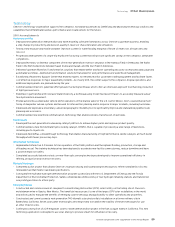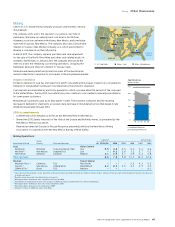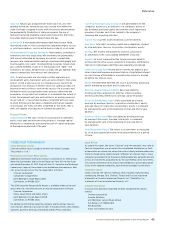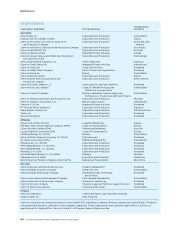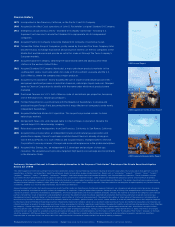Chevron 2010 Annual Report Download - page 67
Download and view the complete annual report
Please find page 67 of the 2010 Chevron annual report below. You can navigate through the pages in the report by either clicking on the pages listed below, or by using the keyword search tool below to find specific information within the annual report.
1879 Incorporated in San Francisco, California, as the Pacific Coast Oil Company.
1900 Acquired by the West Coast operations of John D. Rockefeller’s original Standard Oil Company.
1911 Emerged as an autonomous entity – Standard Oil Company (California) – following U.S.
Supreme Court decision to divide the Standard Oil conglomerate into 34 independent
companies.
1926 Acquired Pacific Oil Company to become Standard Oil Company of California (Socal).
1936 Formed the Caltex Group of Companies, jointly owned by Socal and The Texas Company (later
became Texaco), to manage exploration and production interests of the two companies in the
Middle East and Indonesia and provide an outlet for crude oil through The Texas Company’s
European markets.
1947 Acquired Signal Oil Company, obtaining the Signal brand name and adding 2,000 retail
stations in the western United States.
1961 Acquired Standard Oil Company (Kentucky), a major petroleum products marketer in five
southeastern states, to provide outlets for crude oil from southern Louisiana and the U.S.
Gulf of Mexico, where the company was a major producer.
1984 Acquired Gulf Corporation – nearly doubling the size of crude oil and natural gas activities –
and gained significant presence in industrial chemicals, natural gas liquids and coal. Changed
name to Chevron Corporation to identify with the name under which most products were
marketed.
1988 Purchased Tenneco Inc.’s U.S. Gulf of Mexico crude oil and natural gas properties, becoming
one of the largest U.S. natural gas producers.
1993 Formed Tengizchevroil, a joint venture with the Republic of Kazakhstan, to develop and
produce the giant Tengiz Field, becoming the first major Western oil company to enter newly
independent Kazakhstan.
1999 Acquired Rutherford-Moran Oil Corporation. This acquisition provided inroads to Asian
natural gas markets.
2001 Merged with Texaco Inc. and changed name to ChevronTexaco Corporation. Became the
second-largest U.S.-based energy company.
2002 Relocated corporate headquarters from San Francisco, California, to San Ramon, California.
2005 Acquired Unocal Corporation, an independent crude oil and natural gas exploration and
production company. Unocal’s upstream assets bolstered Chevron’s already-strong posi-
tion in the Asia-Pacific, U.S. Gulf of Mexico and Caspian regions. Changed name to Chevron
Corporation to convey a clearer, stronger and more unified presence in the global marketplace.
2011 Acquired Atlas Energy, Inc., an independent U.S. developer and producer of shale gas
resources. The acquired assets provide a targeted, high-quality core acreage position primarily
in the Marcellus Shale.
Chevron History
Produced by Comptroller’s Department, Chevron Corporation Design f troop design, San Francisco, California Printing ColorGraphics, San Francisco, California
2010 Corporate Responsibility Report
2010 Annual Report
2010 Supplement to the Annual Report
Cautionary Statement Relevant to Forward-Looking Information for the Purpose of “Safe Harbor” Provisions of the Private Securities Litigation
Reform Act of 1995
This 2010 Supplement to the Annual Report of Chevron Corporation contains forward-looking statements relating to Chevron’s operations that are based on management’s current
expectations, estimates and projections about the petroleum, chemicals and other energy-related industries. Words such as “anticipates,” “expects,” “intends,” “plans,” “targets,”
“projects,” “believes,” “seeks,” “schedules,” “estimates,” “budgets” and similar expressions are intended to identify such forward-looking statements. These statements are not
guarantees of future performance and are subject to certain risks, uncertainties and other factors, some of which are beyond the company’s control and are difficult to predict.
Therefore, actual outcomes and results may differ materially from what is expressed or forecasted in such forward-looking statements. The reader should not place undue reliance
on these forward-looking statements, which speak only as of the date of this report. Unless legally required, Chevron undertakes no obligation to update publicly any forward-looking
statements, whether as a result of new information, future events or otherwise.
Among the important factors that could cause actual results to differ materially from those in the forward-looking statements are: changing crude oil and natural gas prices; changing
refining, marketing and chemical margins; actions of competitors or regulators; timing of exploration expenses; timing of crude oil liftings; the competitiveness of alternate-energy
sources or product substitutes; technological developments; the results of operations and financial condition of equity affiliates; the inability or failure of the company’s joint-venture
partners to fund their share of operations and development activities; the potential failure to achieve expected net production from existing and future crude oil and natural gas
development projects; potential delays in the development, construction or start-up of planned projects; the potential disruption or interruption of the company’s net production or
manufacturing facilities or delivery/transportation networks due to war, accidents, political events, civil unrest, severe weather or crude oil production quotas that might be imposed
by the Organization of Petroleum Exporting Countries; the potential liability for remedial actions or assessments under existing or future environmental regulations and litigation; sig-
nificant investment or product changes under existing or future environmental statutes, regulations and litigation; the potential liability resulting from other pending or future litigation;
the company’s future acquisition or disposition of assets and gains and losses from asset dispositions or impairments; government-mandated sales, divestitures, recapitalizations,
industry-specific taxes, changes in fiscal terms or restrictions on scope of company operations; foreign currency movements compared with the U.S. dollar; the effects of changed
accounting rules under generally accepted accounting principles promulgated by rule-setting bodies; and the factors set forth under the heading “Risk Factors” on pages 32 through
34 of the company’s 2010 Annual Report on Form 10-K. In addition, such statements could be affected by general domestic and international economic and political conditions.
Unpredictable or unknown factors not discussed in this report could also have material adverse effects on forward-looking statements.
2010 Corporate Responsibility Report
2010 nnual Report
2010 Supplement
to the Annual Report






